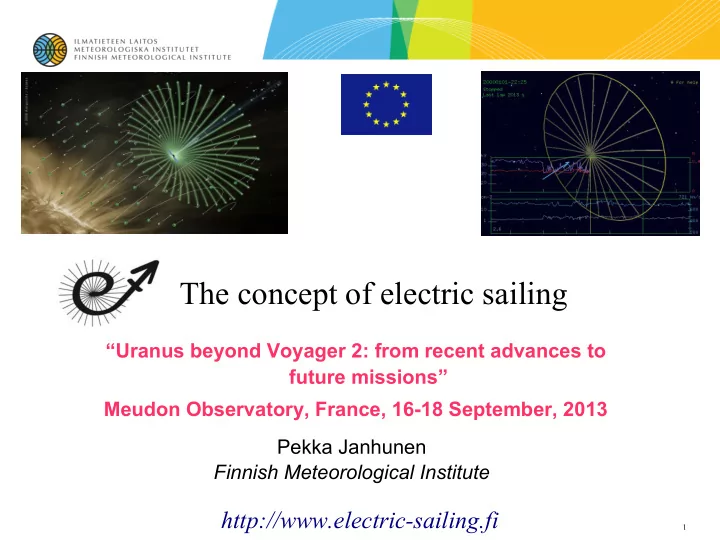

The concept of electric sailing “Uranus beyond Voyager 2: from recent advances to future missions” Meudon Observatory, France, 16-18 September, 2013 Pekka Janhunen Finnish Meteorological Institute http://www.electric-sailing.fi 1
Contributors Petri Toivanen, Jouni Envall, Jouni Polkko, Sini Merikallio, Henri Seppänen (Finnish Meteorological Institute), Pekka Salminen (SkyTron, Finland), Edward Haeggström, Timo Rauhala, Jukka Ukkonen, Göran Maconi, Anni Toppila (Univ. Helsinki, Finland), Sergiy Kiprich (NSC Kharkov Inst. Physics, Ukraine), Hannu Koivisto, Olli Tarvainen, Taneli Kalvas, Antti Nuottajärvi (Univ. Jyväskylä, Finland), Alexander Obraztsov (Univ. Eastern Finland at Joensuu, and Moscow State Univ.), Greger Thornell, Sven Wagner, Johan Sundqvist (ÅSTC, Uppsala, Sweden), Tor- Arne Grönland, Kristoffer Palmer (Nanospace AB, Uppsala, Sweden), Roland Rosta, Tim van Zöst (DLR-Bremen, Germany), Mart Noorma, Viljo Allik, Silver Lätt, Urmas Kvell (Univ. Tartu, Estonia), Giovanni Mengali, Alessandro Quarta, Generoso Aliasi (Univ. Pisa, Italy), Salvo Marcuccio, Pierpaolo Pergola, Nicola Giusti (Alta S.p.A., Pisa, Italy) http://www.electric-sailing.fi 2
Electric sail ● Coulomb drag with natural solar wind pushes spacecraft ● Long, charged tethers (10-20 km, 25-50 μ m wire, +20-40 kV) ● Max 1 N thrust from <200 kg package (at 1 au; scales ~1/ r ) ● Hardware is at TRL 4-5 ● ESTCube-1 is flying, waiting for experiment to start... Janhunen et al., Rev. Sci. Instrum. , 2010 http://www.electric-sailing.fi 3
Plasma simulation of E-sail (With nominal solar wind parametres at 1 au) 4
Approximate thrust formula V 0 = 20 kV tether voltage V 1 = 1 kV solar wind proton energy P dyn = ρ v ² = 2 nPa solar wind dynamic pressure R = 100 m electron sheath radius r w = 1 mm effective electric width of tether ==> dF / dz = 500 nN/m thrust per tether length 5
Tether manufacture 1 km tether ( m =11 grams) 10 m ESTCube-1 tether Seppänen et al., Rev. Sci. Instrum. , 2013 http://www.electric-sailing.fi 6
Ultrasonic bonding tether factory http://www.electric-sailing.fi 7
ESTCube-1 mission ● Estonia's first satellite ● Launched May 8, 2013 with Vega to 670 km orbit ● Will deploy 10 m tether, charge it to 500 V and measure LEO E-sail effect by sync-deltaspin method http://www.electric-sailing.fi 8
Aalto-1 mission (2014) • 3U CubeSat of Aalto University, Finland • Longer tether (100 m), higher voltage (1 kV) http://www.electric-sailing.fi 9
Some classes of E-sail applications ● Multi-asteroid touring missions ● Asteroid deflection (e.g. retrograde impactors, or gradually) ● Non-Keplerian orbit missions ● e.g., off-Lagrange point space weather monitoring ● As a “booster” for outer solar system missions ● Such as Uranus (!) ● Replacement of gravity assist manoeuvres: faster & more frequency launch windows & lower launch mass ● Also outer-of-heliosphere missions http://www.electric-sailing.fi 10
Conclusions: where do we stand? ● Propulsion revolution around the corner? May well be. ● We are at TRL 4-5 now – it wasn't difficult to get here ● We think we know how to build a 0.5-1 N, 100-200 kg sail ● We need an in-orbit deployment demonstration ● We need to measure the effect in the solar wind http://www.electric-sailing.fi 11
Recommend
More recommend